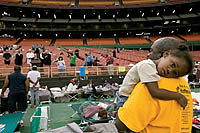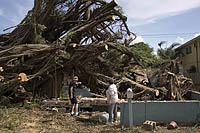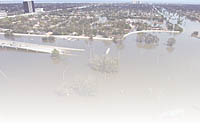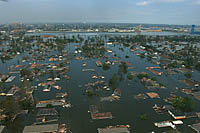A BNP Media staff report


The worst part was the long days and even weeks being out of touch with loved ones and business associates. Ferguson, Hughes Supply, Coburn Supply, McJunkin and Red Man Pipe & Supply were some of the PHCP distributors that suffered a week or more of anxious moments trying to locate missing employees. As we went to press, the Southern Wholesalers Association was still trying to collect detailed information about the impact on SWA membership. (See box about their relief fund.)
Thankfully, by the time we went to press all industry citizens had been accounted for as far as we know. Buildings, trucks and equipment didn't fare as well, as dozens of PHCP supply houses in the region were knocked out of service, some no doubt permanently. In some cases this may be a moot point, because they were based in communities that may never again be populated.
Coburn Supply, based in Beaumont, Texas, reported losing seven branches in the region. “About eight or nine of our people lost everything,” Coburn Supply President Don Maloney told us in a conversation at the ASA Convention in Orlando Sept. 8. “We're trying to help any way we can, but there's so much to do. Right now we're gathering information about children's clothing sizes and stuff like that.”
The next worst part was not having a clue about what comes next. Many of the Gulf Coast's distressed victims had no idea of when, or even if, they would get back to resuming normal lives.
According to the National Weather Service's National Hurricane Center, Katrina will likely be recorded as the worst natural disaster in U.S. history. The storm produced catastrophic damage and loss along the southern coasts of Louisiana, Mississippi and Alabama. The extent of the devastation has yet to be measured in anything but mega-ballpark estimates, though at every turn one could see billions of dollars more being sucked toward relief and recovery efforts.
On Aug. 23, Katrina formed from a tropical wave and became a depression roughly 175 miles southeast of the Bahamas. The next day it was classified as a tropical storm moving northwest, ultimately turning west to South Florida.
Gaining strength, Katrina became a minimal Category 1 hurricane the evening of Aug. 25, hitting Miami-Dade/Broward County. It dumped more than a foot of rain and toppled trees and power lines. The Florida Keys also got hit with what in retrospect seems a featherweight's jab.
When it entered the Gulf of Mexico, Katrina grew to maximum Category 5 strength by Aug. 28. Peak winds were recorded at 175 mph. Pressure fell to 902 millibars, the fourth lowest barometer reading ever recorded on this planet.
Turning to the northwest, then north, Katrina diminished slightly and on Aug. 29 slammed into the Louisiana Gulf Coast as a Category 4 storm with 140-mph sustained winds. One eyewitness reported, “100-year-old live oak trees were snapped off like dry twigs and sent crashing down into homes or sailing 100 yards away into other buildings like missiles.” Even so, at first it seemed that New Orleans had escaped the brunt of the storm. Then its levee broke - in one spot, it was thought, from a huge barge tossed like a toy boat against the barrier.
Left behind was devastation that turned the lives of more than a million people upside down. It left all but uninhabitable the fun-filled city of New Orleans, its 600,000+ population mostly scattered throughout the country, thousands feared dead.
What follows are several reports we received from industry citizens who had close encounters with Katrina.

What Comes First?
Parks, Peyton & Sasser is a PHCP manufacturers rep down South. Its warehouse is in north Louisiana (Hammond), so it was untouched by Katrina physically. But its territory is along the now infamous I-10 corridor toward southern Louisiana, and phone lines weren't working for weeks after the disaster.“We need every last order we can get to survive, and we can't get any kind of phone calls or faxes,” said Frank Parks, one of the principals. “Missed phone calls are killing us.”
Any shipments en route to customers in the Gulf Coast when the storm hit are lost in limbo. For anybody in the rep business, said Parks, regardless of your industry, if your territory was Louisiana and Mississippi, you just lost 40% of your territory.
"Something needs to be made clear: New Orleans is only 30% of the area," Parks explained. "When I say 'New Orleans' I am talking about the 1.3 million people that live within the waterways of the Mississippi River, Lake Pontchartrain, and Lake Borgne. When Mayor Nagin speaks about New Orleans, he is talking about the 400,000 people who make up the tiny part of the city called New Orleans. I do a ton of business in New Orleans, but I ship to cities such as Metairie, Harahan, Kenner, Harvey - very rarely New Orleans. There are no supply houses in the city anymore." Suppliers such as Southland Plumbing Supply in Metairie, La., deliver product into the city of New Orleans, he added.
“People say, 'Oh, what a building boom you'll have.' Yeah, if we can only stay in business until that happens,” Parks commented. “This is likely to have a devastating impact on business fortunes months down the road. Some of our customers owe hundreds of thousands of dollars to manufacturers. Where will the receivables come from to pay these bills?”
No commission dollars were being earned in the New Orleans to Pascagoula corridor. Even if the supply houses were open, who could they sell to? What will come first, he wondered, businesses so people can get paychecks, or houses so people can live and go to work?
The first week of September Parks had seven people, two dogs and three cats staying at his home, including a key employee of one of his customers along with his family and friends. As of mid-September, Parks was still housing two dogs and a customer's friend.
"Our biggest loss will be receivables."
Wholesaler Southland Plumbing Supply reported that one of its two Kohler Premier showrooms, its headquarters facility in Metairie, La., and its storage warehouse about a mile from there were damaged by Katrina. Damage included a wall that fell over and a broken overhead door. Also there may have been looting because the building was exposed for a week and 12,000 evacuees were roaming the streets less than two blocks away.Now those buildings have mold and the company assigned a crew to sanitize and disinfect.
“Everyone who works for me and anyone entering those areas had to get shots: Hepatitis ABC and tetanus,” said Alan Vinturella, owner and president.
Southland has been in business since 1968, supplying plumbing fixtures, faucets, whirlpool tubs, toilets, accessories and pipe and fittings, as well as serving as the supplier for commercial and industrial projects in Louisiana and Mississippi.
As of Sept. 14, the wholesaler was manning its warehouse mostly for emergency supply and repair, but had not received mail for two and a half weeks, had not heard from 20 of its 50 employees and was handwriting orders and invoices. Three employees, including Vinturella's son, were working in the company's Mandeville, La., showroom, which was not affected by Katrina, and about 11 employees were in the Metairie headquarters, working with hospitals, schools and plumbers on emergency-related business.
Vinturella estimated a full scale return to business by early October.
“I'm going to lose some of my valued employees,” he said. Some of the showroom employees with children relocated to Dallas, Chicago or Tallahasee, Fla., and enrolled their children in schools. They may not return to New Orleans. ”We have to dig up files and train new people,” he said. “Our biggest loss will be receivables. About 80% of our customers are based in New Orleans. If a customer is a single-truck operation and his truck and his house were destroyed by Katrina, why would he come back to do business here?”
Vinturella said he has told some employees to file for unemployment compensation. Out of the original 50 employees he may reopen with 15 or 20 on staff.
“I'm optimistic,” he confided. “I was born and raised in New Orleans. We are all locals, and locals want to deal with locals. A lot has to do with New Orleans' plan for rebuilding. I have seen three or four different plans. I have every intention of staying in New Orleans and being part of the rebuilding. I want to see the city come back. I'll be extremely interested to see the demographics of New Orleans about a year from now - just hope there is some silver lining to this very dark cloud.”
Vinturella's personal life was also impacted. His house suffered damage from the hurricane but no flooding. There were leaks from roof damage and buckling floors.
His in-laws had 16 feet of water and his mother had about two feet of water and now has mold stretching about six feet high. She will probably have to give up her house.
“I love the business, dealing with reps and factories,” Vinturella said. “I hope a year from now there will be some sense of normalcy.”

“We're horror-stricken.”
Kelly Bryson is the executive vice president/COO of Berg Inc., a prominent mechanical contractor based in Shreveport, La. When he communicated with one of our colleagues on Sept. 1, the company still hadn't located all New Orleans employees. Some were working out of the company's Shreveport and Lafayette, La. locations, while others had been evacuated to Arkansas and north Mississippi. “We believe most of our folks evacuated in time, but there are still several people we haven't been able to contact,” Bryson told us.Technicians from Shreveport were scheduled to join the boat search and rescue effort the following week, but that was put on hold due to attacks on the boat-rescuers that were common in the widely reported anarchy following the storm.
“We're horror-stricken by the stories we're hearing from the area,” said Bryson. “Baton Rouge has over 100,000 of the evacuees, and robberies, carjackings and attacks are on the rise in this area as well.”
“Our employees here are donating clothing, diapers, non-perishables to the evacuees in area shelters, and we're organizing a donation drive with our vendors and customers,” said Bryson. “We're committed to doing all we can for our employees, their families and the other evacuees.”
Money balks.
Contractor Jim Finley's home is on the outskirts of New Orleans, and his house fared better than most, he told us. His plumbing company, on the other hand, he's not so sure about.C.N. Finley Inc. had 12 employees, who were scattered when Katrina hit - and some had Finley service trucks with them. Though he knows they're all safe, when they'll begin working again, that's another story.
Flying over the city at 7,000 feet on his way to Orlando to attend Network '05, where he was elected PHCC-NA vice president, Finley could see the devastation and described it as a “ghost town.” Water touched everywhere and everyone. Finley wondered when life - especially business life - would get back to normal.
“There is no working post office, no working bank, which means no checks are being delivered, no funds being transferred,” he told us. Finley was working on getting his technicians their last paycheck, and making them eligible for unemployment insurance, even if that meant officially firing them for a while.
With dislocation so widespread, rebuilding seemed months down the road. The daily business transactions we take for granted - ordering from supply houses, depositing money, paying bills - were all wiped out. It's “stone age” time, Finley said. “The money is just not moving.”

What next?
As this was written two and a half weeks after the event, rebuilding was still a long way off. First comes cleanup, a job likely to take months. Then comes damage assessment, followed by decisions to determine what structures should be rebuilt, and where.Mississippi River barge traffic took a major hit. The port of New Orleans opens to a river system serving 33 states and connecting to six railroads. The region as a whole is home to six of the top 15 ports in tonnage and handles more than 500 million tons of cargo a year - more than all the waterborne shipments of California, Florida, New York and Alaska combined. In the immediate aftermath of Katrina, shipments had to be diverted through Lake Michigan for inland distribution. Railways and alternative routes added to delays and expense. According to one estimate, to replace one tug boat hauling 15 barges requires more than two 100-car freight trains, or 870 trucks stretching over 34 miles of highway. This at a time of skyrocketing fuel costs.
Initial reports estimated river traffic to be shut down for months in the vicinity of New Orleans, although evidence of American resiliency could be seen in the opening of limited barge shipping on Sept. 13. That was also the day of the first commercial flight into Louis Armstrong New Orleans International Airport since Katrina struck on Aug. 29.
With thousands of contractors and other customers knocked out of business for who knows how long, PHCP manufacturers and wholesalers would likely see business severely disrupted for the remainder of 2005.
“Hurricane Katrina has radically changed the outlook for construction demand throughout the country for an indefinite period,” said AGC's chief economist Ken Simonson, writing on Sept. 6. “Katrina may significantly disrupt supplies of construction inputs, including diesel fuel, other petroleum and natural-gas products, cement (9% of cement imports in 2004 came through New Orleans and downstream ports), and tires for heavy equipment (New Orleans is an entry point for imported rubber).
“Whether recovery from Katrina adds to demand for construction materials depends on the types and speed of rebuilding in damaged areas or incremental construction activity in areas where displaced people and businesses relocate,” Simonson continued. “So far, the storm has pulled work crews in to plug breached levees and canals and begin restoring power, communication, water, sanitation, and transportation infrastructure. But many of these workers were pulled off other jobs rather than being new hires.”
Yet, while Katrina seems certain to be a continuing ill wind for the short term, it could well set the stage for a Category 5 recovery boom a year or two down the road. Some 200,000 hurricane victims are living in temporary shelters and will need new housing, for instance. Destructive as this hurricane may have been, you can be sure its clouds contained some silver linings.
Contributing to this article were Jim Olsztynski, Pat Lenius, Suzette Rubio, Katie Rotella, Kelly Faloon and Steve Smith.

Protecting Good Samaritans
Shortly before we went to press, legislation was introduced in the U.S. House of Representatives to provide measured protections to contractors who respond to declared federal, state and local emergencies or disasters.“The Good Samaritan legislation is designed to provide contractors, such as those responding to Hurricane Katrina, with qualified immunity from liability when providing services in volunteer situations that arise from a disaster or emergency,” said Stephen E. Sandherr, CEO of the Associated General Contractors, which was instrumental in developing the legislation. “When construction expertise is needed, there should not be anything to make the construction industry hesitant in responding to help and possibly save lives and property.”
Co-sponsoring the bill were Reps. Dave Reichert (R-Wash.), Gary Miller (R-Calif.), Dan Lungren (R-Calif.) and Jim Matheson (D-Utah). Specifically, the bill would provide construction entities with immunity from liability for negligence when providing services or equipment on a volunteer basis in response to a declared emergency or disaster. It would not cover gross negligence or willful misconduct. Moreover, those protected under the bill would be providing such assistance at the direction of a public official acting in an official capacity.
SWA's Relief Fund
The Southern Wholesalers Association has established an SWA Katrina Relief Fund through Bank of America to collect funds and disperse them to association member companies and their staff who were hurricane victims. SWA guarantees that 100% of the funds collected will go to those in need.Mail your support to:
SWA
P.O. Box 681966
Franklin, TN 37068-1966
Please note on each check that it be designated for the SWA Katrina Relief Fund.
